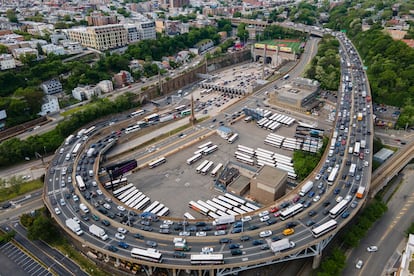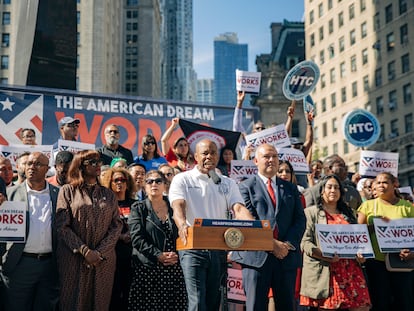A $15 toll to drive into part of Manhattan has been approved, a first for US cities
Supporters of the tolls say it will push more people to use public transport and reduce congestion to speed up public buses and emergency vehicles

New York is on track to become the first U.S. city with congestion tolls on drivers entering its central business district after transit officials approved a $15 fee for most motorists headed into part of Manhattan. Members of the Metropolitan Transportation Authority board on Wednesday voted to greenlight the congestion pricing plan, expected to go into effect in June. The board approved only minor changes to a plan presented to the public months ago, and brushed off requests for exceptions by dozens of groups of commuters.
The vote authorizes a $15 toll on most commuter passenger vehicles that drive into Manhattan south of 60th Street, a zone that’s south of Central Park, during daytime hours. Tolls are higher for larger vehicles, and lower for late-night entries into the city, as well as for motorcycles.
Supporters of the new tolls say it will push more people to use public transport, reduce congestion to speed up public buses and emergency vehicles, reduce pollution, and raise money needed to improve the subway system.
The state Legislature approved the tolls in 2019, mandating that the program should raise $1 billion per year to fund public subway and bus systems for the city’s 4 million daily riders. It also established the boundaries of the zone, which covers the busiest part of the city, and scaled back early proposals to include the area up to 86th Street. The pandemic and lack of federal regulation stalled the project.
Tolls will vary based on the time of day and the size of the vehicle, ranging from $1.75 for motorcycles crossing overnight to $36 for sightseeing buses and trucks with trailers during the day. The overnight period runs from 9 p.m. to 5 a.m. on weekdays, and from 9 p.m. to 9 a.m. on weekends.
Visitors without E-ZPasses — a device that collects toll information remotely — will pay more. And as on bridges, license plate readers are expected to identify other drivers, so that they can be billed by mail.
Taxis will charge passengers $1.25 per trip that touches the zone, while app-based rides will charge $2.50.
The vote Wednesday followed two months of public comment in which over 100 categories of drivers asked to be exempted from the tolls. They ranged from small groups like holders of diplomatic license plates to large groups like residents of the neighboring states of New Jersey and Connecticut. Commuters from other states and boroughs already pay tolls for bridges and tunnels to the island of Manhattan, and the congestion fee will come on top of that.
But the $1 billion in toll revenue mandated by the state law meant that eliminating charges for one group would increase the price for everyone else, so most requests for exceptions weren’t granted.
Some exceptions survived, including a free pass for emergency vehicles, specialized city vehicles, and buses with regular public routes or city school contracts. Vehicles carrying disabled people and certain low-income commuters also get a pass. Low-income drivers are eligible for discounts and tax credits.
New York’s plan has drawn lawsuits from small business owners and the state of New Jersey.
If the plan survives those legal challenges, New York will become the first U.S. city to implement a congestion pricing scheme. Such schemes have been implemented in London, Stockholm, Milan and Singapore.
In 2017, Virginia officials implemented a toll system to reduce congestion during rush hour on Interstate 66 near Washington, D.C.
Sign up for our weekly newsletter to get more English-language news coverage from EL PAÍS USA Edition
Tu suscripción se está usando en otro dispositivo
¿Quieres añadir otro usuario a tu suscripción?
Si continúas leyendo en este dispositivo, no se podrá leer en el otro.
FlechaTu suscripción se está usando en otro dispositivo y solo puedes acceder a EL PAÍS desde un dispositivo a la vez.
Si quieres compartir tu cuenta, cambia tu suscripción a la modalidad Premium, así podrás añadir otro usuario. Cada uno accederá con su propia cuenta de email, lo que os permitirá personalizar vuestra experiencia en EL PAÍS.
¿Tienes una suscripción de empresa? Accede aquí para contratar más cuentas.
En el caso de no saber quién está usando tu cuenta, te recomendamos cambiar tu contraseña aquí.
Si decides continuar compartiendo tu cuenta, este mensaje se mostrará en tu dispositivo y en el de la otra persona que está usando tu cuenta de forma indefinida, afectando a tu experiencia de lectura. Puedes consultar aquí los términos y condiciones de la suscripción digital.
More information
Archived In
Últimas noticias
ICE raids trigger school absenteeism and traumatize children: ‘They have been forced to leave their childhood behind’
Mexico’s missing people crisis casts a shadow over World Cup venue
James Cameron: ‘For the films I like to make to continue to exist, we have to find a way to make them cheaper’
Families demand repatriation of bodies of Colombians who died in Ukraine: ‘This war is a slaughterhouse for foreigners’
Most viewed
- Christian Louboutin: ‘Young people don’t want to be like their parents. And if their parents wear sneakers, they’re going to look for something else’
- US sanctions against jailed cartel leader ‘El Marro’ highlight Mexico’s lack of control over its prisons
- Cartels in Mexico take a leap forward with narco-drones: ‘It is criminal groups that are leading the innovation race’
- Liset Menéndez de la Prida, neuroscientist: ‘It’s not normal to constantly seek pleasure; it’s important to be bored, to be calm’
- ‘El Limones’ and the growing union disguise of Mexican organized crime










































